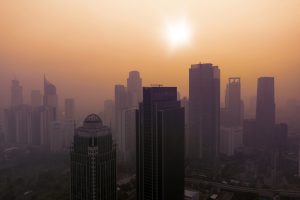During the dry season each year, the vibrant skyline of Indonesia’s capital Jakarta becomes something of a fading memory, disappearing under a thick brownish-grey smog.
The city’s notorious levels of air pollution have arisen predominantly from the ever-rising usage of fossil-fuel-powered vehicles and the extensive industrial operations enveloping the capital city. The situation is not helped by the fact that Jakarta’s unintegrated public transportation system gives commuters no choice but to rely on private vehicles. Consequently, the daily commute has for the city’s population grown into a distressing and exhausting experience – one that has also contributed to making the city’s air deeply unhealthy to breathe. The extent of the problem was highlighted last month when Jakarta was awarded the unwelcome title of the city with the most polluted air in the world.
Given the current urban planning and industrial progress, Jakarta’s pollution challenge has reached a point where there is limited potential for immediate remediation and no concrete solutions on the horizon. In response to this growing environmental challenge, the government has been able to do little more than strongly advise people to reduce outdoor activities and install indoor air purification systems.
The restoration of Jakarta’s air quality will require a comprehensive overhaul of its urban infrastructure and transport system, along with the creation of satellite urban centers surrounding the capital. This strategy, which could relieve the strain of increasing population density and commuter volumes, could well be helped by the fact that the country is currently developing a new capital city, 1,200 kilometers away on the island of Borneo.
Having learnt from Jakarta’s congestion and smog, President Joko Widodo and his government are committed to designing Ibu Kota Nusantara – the Nusantara Capital – as a renewable-energy-based smart metropolis. Nusantara, the government claims, will be built as a “forest city” with an integrated, and low-emission transportation network. While this is an ambitious and welcome goal, there are questions as to whether the initiative will survive beyond the end of his second term in February 2024. A change in leadership, as is often the case, can compromise the continuity of previously announced major programs. If Nusantara does not pursue the concept that has been established, it will undoubtedly disappoint many parties and waste the ideas, effort, and money already invested in this project.
At the same time, there are questions about the environmental impact of the new capital city, which will occupy 36,000 hectares of rainforest, in particular the possible adverse effects on water quality and ecological stability. Furthermore, as certain sections of Nusantara are sited upon vulnerable peatlands, there exists an inherent risk of fire.
The use of modern technologies in the construction of the new capital city will be critical to creating effective urban planning and governance. By embracing the smart city concept, Nusantara has the potential to become a modern, efficient, and sustainable city. Furthermore, prioritizing the use of clean and renewable energy sources, particularly the development of sustainable electrical infrastructure, would both increase energy security and establish the groundwork for the city’s growth. Using renewable energy is possible because East Kalimantan has abundant potential for solar power and water.
It is also vital to prevent the opening of industrial estates around the new city that could generate pollution and environmental deterioration. It will be better if the new capital city is established as a center of government, technology, and culture to create a new center of sustainable growth. Furthermore, innovative and integrated transportation solutions that enable efficient and ecologically friendly mobility are required. The Nusantara Capital can reduce congestion and greenhouse gas emissions while offering good accessibility by optimizing electric vehicles and building a well-organized public transportation system that integrates the capital city with its surrounding satellite cities.
Nusantara can benefit from examining the experiences of Zurich and Singapore, two of the world’s most advanced smart cities. Sustainability and technology, particularly the use of the internet of things in practically all industries, have been critical to the success of both cities. Digital technology has also helped to improve people’s quality of life by allowing them to work more efficiently. Aside from that, these cities have numerous strategies aimed at reaching their net-zero emission goals, such as waste management, reduced power use, and integrated public transportation.
The change in leadership from Jokowi to his successor may impede the Nusantara Capital Development. To ensure the long-term viability of this enormous project, a long-term commitment and a strategy for engaging the future government are required. Prioritizing renewable energy sources from the outset can set a precedent for the next administration to maintain the sustainable development of Nusantara. Learning from Jakarta’s experience with pollution, where unchecked growth has led to severe environmental degradation, the new capital must prioritize strict environmental regulations and pollution control measures, thereby avoiding the thick smog that afflicts Indonesia’s current capital.

































